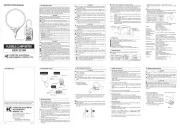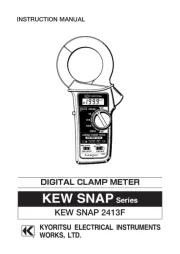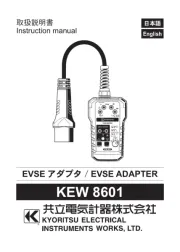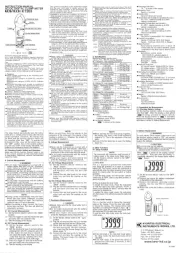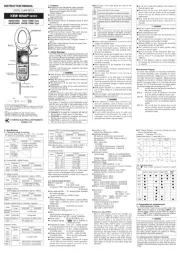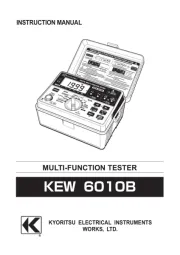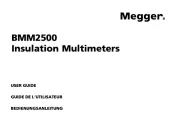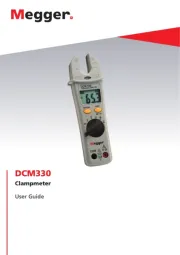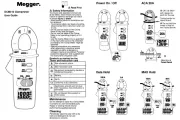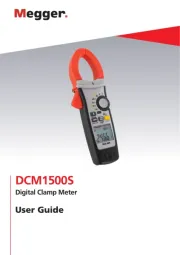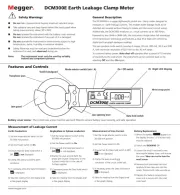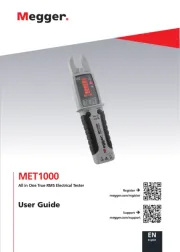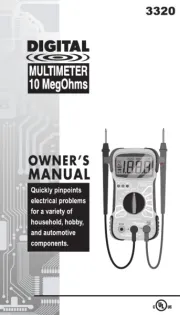
This instrument has been designed, manufactured and tested
according to IEC 61010: Safety requirements for Electronic measuring
apparatus, and delivered in the best condition after passed the
inspection. This instruction manual contains warnings and safety rules
which must be observed by the user to ensure safe operation of the
instrument and retain it in safe condition. Therefor
these operating instructions before using the instrument.
● Read through and understand the instructions contained in this
manual before starting to use the instrument.
● Keep the manual at hand to enable quick reference whenever
● The instrument is to be used only in its intended applications.
● Understand and follow all the safety instructions contained in the
It is essential that the above instructions are adhered to. Failur
follow the above instructions may impair the protection provided by
the instrument, and may cause injury, instrument damage and/or
damage to the equipment under test.
The symbol indicated on the instrument means that the user #
must refer to the related parts in the manual for safe operation of the
instrument. It is essential to read the instructions wherever the symbol
# DANGER is reserved for conditions and actions that are likely to
cause serious or fatal injury.
# WARNING is reserved for conditions and actions that can cause
# CAUTION is reserved for conditions and actions that can cause
injury or instrument damage.
● Never make measurement on a circuit in the following categories;
Measurement category IV(CAT IV):over 600V
Measurement category III(CAT III):over 1000V
● Do not att empt to make me asurement in the pr esence of
flammable gasses. Otherwise, the use of the instrument may
cause sparking, which can lead to an explosion.
Never attempt to use the instrument if its surface or your hand is wet.
Do not exceed the maximum allowable input of any measuring ranges.
Never open the Battery compartment cover during a measurement.
To avoid getting electrical shock by touching the equipment under
test or its surroundings, be sure to wear insulated protective gears.
● Never attempt to make any measurements if the instrument has
any structural abnormalities, such as a crack, or if the cover
● The instrument should be used only in its intended applications
or conditions. Otherwise, safety functions equipped with the
instrument do not work, and instrument damage or serious
personal injury may be caused.
● Never attempt to make measurement if any abnormal conditions,
such as broken case and exposed metal parts are found on the
● Verify proper operation on a known source before starting to use
the instrument or taking action as a result of the indication of the
● Do not install substitute parts or make any modifications to the
instrument. Return the instr
ument to your local KYORITSU
distributor for repair or re-calibration in case of suspected faulty
● Do not try to replace the batteries if the surface of the instrument
● Ensure that the Clamp sensor is disconnected from the object
under test, and that the instrument is powered off when opening
the Battery compartment cover for battery replacement.
● This instrument is designed for residential, commercial or light
industry applications. Accurate results may not be obtained if
equipments generating strong electromagnetic interferences
or strong magnetic fields due to large currents exist in the
● Set the Function switch to the appropriate position before starting
● This instrument isn t water proofed. Keep
● Be sure to power off the instrument after use. Remove the
batteries if the instrument is to be stored and will not be in use for
● D o n ot e x po s e t he in st r um e nt t o d ir e ct s u nl i gh t , h ig h
temperatures, humidity or dew.
● Use a damp cloth with water or neutral detergent for cleaning the
instrument. Do not use abrasives or solvents.
● Marks listed below are used on this
User must refer to the explanations in the instruction
Instrument with double or reinforced insulation.
Must wear insulated gears such as a pair of rubber gloves
when connecting / disconnecting the sensor to / from live
Cros sed-ou t whee l bin symbol (acco rding to WE EE
Directive: 2002/96/EC) indicating that this electrical product
may not be treated as household waste, but that it must be
collected and treated separately.
● Measurement categories(Over-voltage categories)
To ensure safe operation of measuring instruments, IEC 61010
establishes safety standards for various electrical environments,
AT IV, and called measurement categories.
Higher-numbered categories correspond to electrical environments
with greater momentary energy, so a measuring instrument designed
for CAT III environments can endure greater momentary energy than
O : Circuits which are not directly connected to the mains power
CAT II : Electrical circuits of equipment connected to an AC ele
CAT III : Primary electrical circuits of the equipment connected directly
to the distribution panel, and feeders from the distribution
CAT IV : The circuit from the service drop to the service entrance, and
to the power meter and primary overcurrent protection device
● Flexible and light weight Sensor with air core coil
● Wide measuring ranges up to 3000A (30A/ 300A/ 3000A)
● Auto-power-off function
● Designed to meet the following safety standard:
IEC 61010-1 (CAT III 1000V / CAT IV 600V Pollution degree 2)
● Measuring range and accuracy(23ºC±5ºC, RH 80% or less)
30A 0.00 - 31.49A 1.50 - 30.00A
(At the center of the circle
formed by the flexible sensor.)
300A 0.0 - 314.9A 15.0 - 300.0A
3000A 0 - 3149A 150 - 3000A
Crest factor (CF): Full scale CF < 1.6, half scale CF < 3.2.
Effective input crest values are 2 times of the max values of each √
● Influence of Conductor position
t accuracy is guaranteed when the measured object is
placed at the center of the clamp sensor.
The following errors should be considered and added to the
accuracy depending on the distance from the center position.
Radius 50 mm (ø100) ±2.0%
Radius 75 mm (ø150) ±3.0%
Applicable standards IEC61010-1, IEC61010-2-030
CAT III 1000V / CAT IV 600V Pollution degree 2
IEC61010-2-032 , IEC61326-1(EMC)
Display Liquid crystal display
Refresh rate Approx. 2 times per second
Location for use In-door use, altitude 2000m or les
& humidity 0 to +50 RH80 or less (no condensation)℃ %
& humidity -10 to +60 RH70 or less (no condensation)℃ %
Power source Size AAA battery x 2 pcs
(The use of alkaline LR03 is recommended.)
Approx. 120 hours continuous (with Backlight off)
Low battery warning appears when the battery voltage drops
Auto-power-off Power off function operates in 15 min. after the
Overload Protection AC 5000A for 10 sec.
Add 0.1 x specified accuracy/ ºC
(above 28ºC or below 18ºC)
Withstand voltage AC8200V for 5 sec
(between clamp sensor and enclosure)
Insulation resistance 100M or more/ 1000VΩ
Conductor size Max. 150mmФ
Dimension 120(L)x70(W)x26(H)mm
Weight Approx. 300g (including batteries)
Cable length Approx. 1.8m(between clamp sensor and main
Accessory Carrying case MODEL9174 x 1 pce
Instruction manual x 1 pce
(1) Checking battery voltage
Set the Function switch to any position other than the OFF position.
When the indications on the display are clearly legible and the
" mark is not on, the battery voltage is OK.
If the display is blank or "
" mark is on, replace the batteries
according to Section 8: Battery Replacement.
● When the instrument is left powered on, the Auto-power-off
function automatically shuts the power off; the display will be
blank even if the Function switch is set to any positions other than
the OFF position in this state.
To power on the instrument, rotate the Function switch or press
any of the buttons. If the display is still blank, the batteries are
(2) Checking Function switch position
Set the Function switch to the appropriate range according to the
measurement purpose. Confirm that the Data hold function is not
6. Operating instructions
● Never make measurement on a circuit in the following categories;
● Never open the Bat tery compartment c over while making
● To avoid getting electrical shock by touching the equipment under
test or its surroundings, be sure to wear insulated protective
the illustration to the right.
(2) Clamp onto one conductor under the test, and re-connect the Joint
connector. Hold the conductor at the center of the Clamp sensor.
(3) Confirm that the Joint connector on the Clamp sensor is firmly
● Jointed part of the Clamp sensor may be disconnected if excessive
● Clamp onto one conductor only; measurements cannot be made
when clamping single-phase (2-wi
re) or three-phase (3-wire) at the
7-1 Auto-power-off function
This function is to prevent the battery from being exhausted by the
instrument being unintentionally left on.
The instrument automatically shifts to the power-off state about 15
min after the last Function switch or other switch operation.
To exit from the Auto-power-off status, press any button or set the
Function switch to the OFF pos
ition once, and then set it to the
mark is displayed on the LCD when the Auto-power-off
[To cancel the Auto-power-off function]
To cancel the Auto-power-off function, hold down the Data hold
button and turn the Function switch from OFF position to any other
While this function is disabled,
mark is not displayed on the
[To enable the Auto-power-off function again]
Turn the Function switch to the OFF, and then set it to any position.
This is a function to hold measured values on the display.
Press the Data hold button once to hold the current reading. In this
data hold state, the reading is held even if input varies. The " " HOLD
the LCD. To exit the data hold state, press the
Press the Backlight button and turn on/ off the LCD backlight. The
backlight is automatically turned off in 30 sec.
Displayed values can be toggled in the following sequence by
pressing the MIN MAX button.
Maximu m value ( MAX appe ars) - Mini mum value ( MIN
meas ured val ue ( MAX MI N bli nks) -
Maximum value ( MAX appears) -…..
To disable this function, hold down the MIN MAX button at least 2
sec or rotate the Function switch.
● Do not try to replace the batteries if the surface of the instrument
● Ensure that the Clamp sensor is disconnected from the object
under test, and that the instrument is powered off when opening
the Battery compartment cover for battery replacement.
● Never open the Bat tery compartment c over while making
● Do not mix new and old batteries or mix different types of batteries.
● Install batteries in correct polarity as marked inside.
Replace batteries with the new ones when the empty battery mark
is displayed on the LCD. The LCD does not show anything,
even the empty battery mark, when the batteries are completely
[ How to replace batteries ]
(1) Power off the instrument.
(2) Loosen the screw at the backside
of the instrument and remove the
Battery compartment cover.
(3) Remove al l the old ba tteries and
i ns ta l l n ew o n es , t wo si ze AA A
batterie s, in correct p olarity. The
kal ine b atte ry ( LR03) is
(4) Reattach the Battery compartment
cover and tighten the screw.
Ba y c rt t cover tter ompa men
Kyoritsu reserves the rights to change specifications or designs
described in this manual without notice and without obligations.
